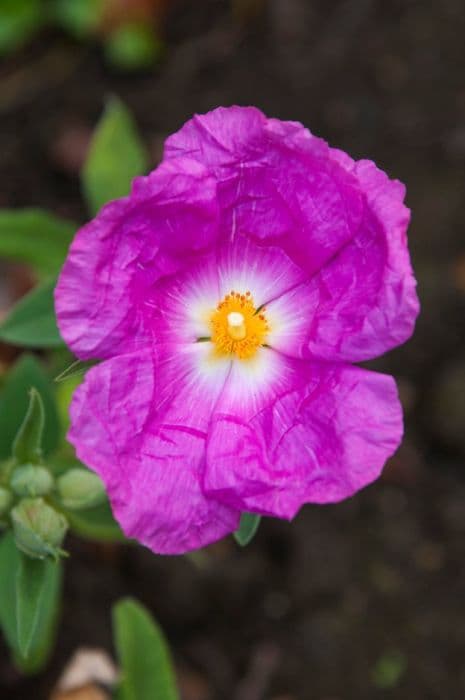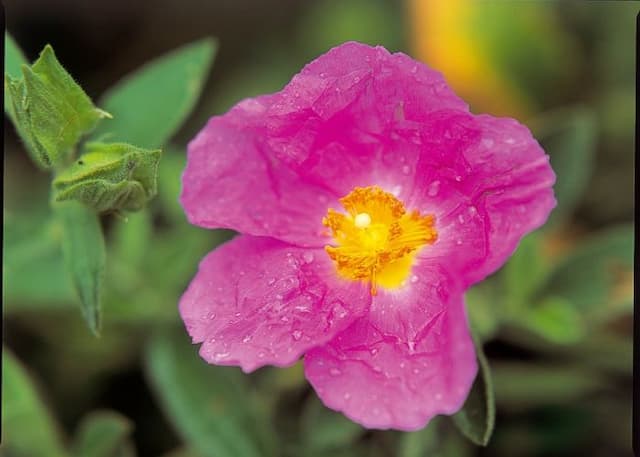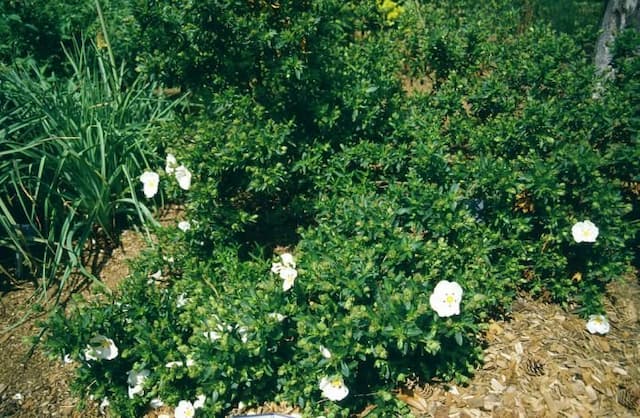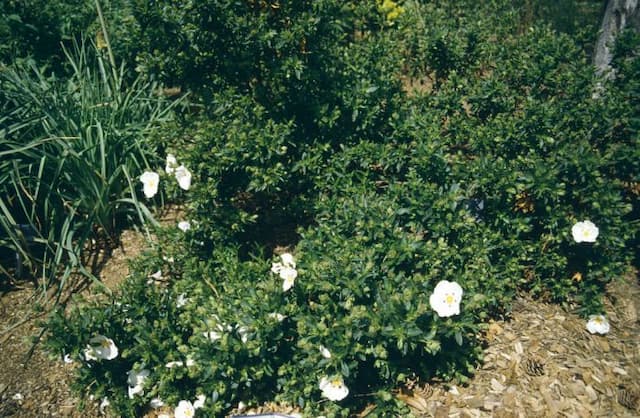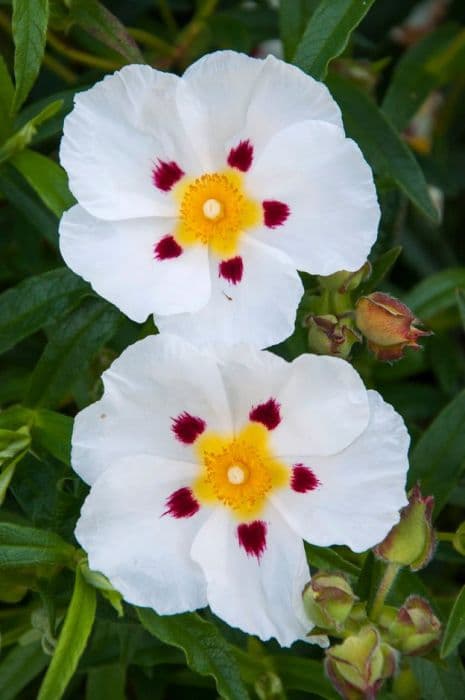Rock Rose Helianthemum 'Golden Queen'

ABOUT
The Helianthemum 'Golden Queen', often referred to as the Rock Rose, bears a striking and cheerful appearance that can brighten any garden. Its foliage is characterized by small, evergreen leaves that provide a dense and low-growing backdrop for the plant's showy flowers. The leaves are often a soft grey-green color, adding to the delicate texture of the plant. The standout feature of the Golden Queen is its profusion of golden-yellow flowers. These blooms are notable for their vibrant color and saucer-shaped form. Each flower has a set of delicate, paper-thin petals that surround a central cluster of stamens. The bright petals are slightly crinkled at the edges, contributing to their charm. These flowers grow in clusters, providing a generous display of color. When in bloom, the Rock Rose becomes a focal point in the garden, drawing attention with its golden hues. The flowering period is also quite long, ensuring months of visual enjoyment throughout the warmer seasons. The overall aesthetic of the Golden Queen is one of natural grace and beauty, with a tendency towards a sprawling form that spills delicately over rocks or garden edges. Its sunny flowers are particularly attractive to pollinators such as bees and butterflies, adding to the dynamism and ecological value of the plant in the garden setting.
About this plant
 Names
NamesFamily
Cistaceae.
Synonyms
Rock Rose, Sunrose, Rushrose, Frostweed, Golden Queen.
Common names
Helianthemum 'Golden Queen'.
 Toxicity
ToxicityTo humans
Rock rose, commonly known as the 'Golden Queen' variety, is not known for its toxicity to humans. There is little to no toxic effect reported from ingesting any part of this plant. However, it is always advisable to avoid eating ornamental plants due to potential unpredicted individual reactions or possible contamination with pesticides and other chemicals.
To pets
Similarly, rock rose, the 'Golden Queen' variety, does not have a reputation for being toxic to pets. It is considered non-toxic to cats, dogs, and other domestic animals. Ingestion of the plant parts should not cause any significant symptoms of poisoning or serious health consequences. Nonetheless, ingestion of non-food plants can sometimes cause gastrointestinal discomfort in pets such as vomiting or diarrhea, so it is better to prevent pets from eating this plant.
 Characteristics
CharacteristicsLife cycle
Perennials
Foliage type
Evergreen
Color of leaves
Green
Flower color
Yellow
Height
1 foot (30 cm)
Spread
1 foot (30 cm)
Plant type
Shrub
Hardiness zones
5
Native area
Europe
Benefits
 General Benefits
General Benefits- Attracts pollinators: The bright flowers of the Rock Rose attract bees and butterflies, which are essential for pollination.
- Drought tolerance: Rock Rose is known for its ability to withstand dry conditions once established, making it suitable for xeriscaping.
- Low maintenance: It requires minimal care beyond the initial establishment period, making it ideal for gardeners seeking low-effort plants.
- Ground cover: Its spreading habit makes it an excellent choice for covering large areas and suppressing weeds.
- Seasonal interest: The Rock Rose offers vibrant yellow flowers that bloom from late spring into summer, adding color to the garden during these seasons.
- Erosion control: The plant’s sturdy root system helps stabilize soil on slopes and in areas prone to erosion.
 Medical Properties
Medical PropertiesThis plant is not used for medical purposes.
 Air-purifying Qualities
Air-purifying QualitiesThis plant is not specifically known for air purifying qualities.
 Other Uses
Other Uses- Photography Prop: Due to its bright and vibrant flowers, the Rock Rose can be used as a natural backdrop or a focus for outdoor photography sessions.
- Erosion Control: Rock Rose's rooting system can help stabilize soil on slopes and prevent erosion in landscapes.
- Dye Production: The pigments from the flowers can potentially be used to create natural dyes for fabrics or other materials.
- Artistic Inspiration: Artists may use the colorful blossoms of Rock Rose as a subject for paintings, drawings, and other forms of artwork.
- Garden Design: The Rock Rose can be used for xeriscaping, which is landscaping designed to minimize water use, due to its drought tolerance.
- Edible Landscaping: Though not widely recognized for culinary uses, the Rock Rose could contribute to an edible landscape for its possible nutritional properties.
- Crafting: Dried petals of the Rock Rose can be included in potpourris or used in crafting, such as in handmade paper or natural confetti.
- Cultural Ceremonies: In certain cultures or local practices, the Rock Rose may be included in ceremonies or used as decoration for festivals and events.
- Literary Inspiration: Rock Rose, with its vibrant aspect, could inspire writers and poets when creating settings or metaphors in their works.
- Children's Education: The plant can be used in educational settings to teach children about plant growth, pollination, and the role of flowers in ecosystems.
Interesting Facts
 Feng Shui
Feng ShuiThe plant Rock Rose is not used in Feng Shui practice.
 Zodiac Sign Compitability
Zodiac Sign CompitabilityThe plant Rock Rose is not used in astrology practice.
 Plant Symbolism
Plant Symbolism- Sunshine and Vibrancy: The 'Golden Queen' is a variation of the Rock Rose and its bright, golden-yellow flowers symbolize the warmth and energy of the sun, often associated with positivity, happiness, and high spirits.
- Resilience: Rock Roses are known for their ability to withstand tough conditions and poor soils; hence, they symbolize resilience, strength, and the ability to thrive in adversity.
- Healing: In some traditions, the Rock Rose is believed to have medicinal properties, representing healing and the restoration of balance.
- Beauty and Appreciation: The aesthetic appeal of the 'Golden Queen' with its radiant blooms is often seen as a symbol of natural beauty and the importance of savoring the present moment.
 Water
WaterThe Rock Rose 'Golden Queen' should be watered deeply but infrequently, allowing the soil to dry out between waterings. Typically, watering once a week during active growth periods is sufficient. In the heat of summer, you may need to water more frequently, but always check the soil moisture first. Ensure you provide a thorough soak, with approximately 1-2 gallons per plant, depending on the size and soil conditions. It's crucial not to overwater as Rock Rose prefers well-draining soil and can be prone to root rot if left in soggy conditions.
 Light
LightThe Rock Rose 'Golden Queen' thrives best in full sun exposure, requiring at least six hours of direct sunlight daily to flourish. Position the plant in a spot where it can receive unfiltered sunlight throughout the day for optimal growth and flower production. An area with southern exposure usually provides the best light conditions to keep the Rock Rose healthy and vibrant.
 Temperature
TemperatureRock Rose 'Golden Queen' is tolerant of a range of temperatures but performs best when daytime temperatures are between 60 to 80 degrees Fahrenheit. It can tolerate minimum temperatures down to around 30 degrees Fahrenheit but should be protected from severe frost. During the winter, ensure that temperatures do not fall below freezing for extended periods to prevent damage to the plant.
 Pruning
PruningPruning the Rock Rose 'Golden Queen' is essential to maintain its shape and encourage bushier growth. Prune lightly in the spring after the last frost to remove any dead or damaged branches and to shape the plant. Additional light pruning can be done after the plant flowers to encourage a second bloom. Typically, pruning once or twice a year is enough for this perennial shrub.
 Cleaning
CleaningAs needed
 Soil
SoilRock Rose 'Golden Queen' thrives in well-draining soil mixed with sand, perlite, and peat to promote drainage. It prefers a soil pH that is slightly acidic to neutral, around 6.0 to 7.5.
 Repotting
RepottingRock Rose 'Golden Queen' typically needs repotting every two to three years, or when it outgrows its container.
 Humidity & Misting
Humidity & MistingRock Rose 'Golden Queen' does well in average humidity levels and does not require high humidity to thrive.
 Suitable locations
Suitable locationsIndoor
Place in bright light, well-draining soil; avoid overwatering.
Outdoor
Full sun, well-draining soil, protect from extreme cold.
Hardiness zone
4-8 USDA
 Life cycle
Life cycleThe 'Golden Queen' rockrose, typically starts its lifecycle when the seeds germinate in late winter to early spring under ideal conditions, which include well-drained soil and plenty of sunshine. After germination, the seedlings grow into small shrubs, developing a woody base and evergreen foliage. Throughout spring and into summer, 'Golden Queen' enters its flowering stage, showcasing vibrant yellow flowers that attract pollinators such as bees and butterflies. After pollination, the flowers produce small, dry fruits containing seeds that, when mature, are dispersed, often by wind or animals, to start a new generation. The plant may enter a period of dormancy during hot, dry summers or cold winters, reducing growth to conserve energy. Perennial in nature, Golden Queen rockrose can live for several years, resuming growth and flowering in subsequent seasons until senescence, followed by death.
 Propogation
PropogationPropogation time
Spring-Early Summer
Propogation: The Rock Rose 'Golden Queen' is commonly propagated by semi-hardwood cuttings. This method usually takes place in late summer. To propagate by cuttings, a gardener would cut a 4 to 6 inch (10 to 15 centimeter) length of semi-hardwood stem that has matured from the current year's growth. The lower leaves are removed, and the cut end is often dipped in rooting hormone powder to encourage root growth. The cutting is then placed in a well-draining potting mix or propagating medium and kept in a warm, humid environment until roots have developed, which generally takes several weeks. To maintain humidity, a plastic bag or propagator can cover the cutting. Once the roots are established, the young plants can be gradually acclimatized to outside conditions before planting out in the garden.
